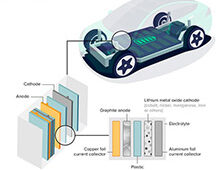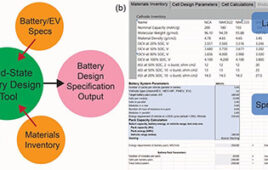Lithium-sulfur
batteries may be the power storage devices of the future. Newly
developed porous nanoparticles containing sulfur deliver optimized
battery performance.
From
smartphones to e-bikes, the number of mobile electronic devices is
steadily growing around the world. As a result, there is an increased
need for batteries that are small and light, yet powerful. As the
potential for the further improvement of lithium-ion batteries is nearly
exhausted, experts are now turning to a new and promising power storage
device: lithium-sulfur batteries. In an important step toward the
further development of this type of battery, a team led by Professor
Thomas Bein of LMU Munich and Linda Nazar of Waterloo University in
Canada has developed porous carbon nanoparticles that utilize sulfur
molecules to achieve the greatest possible efficiency (see paper in Angewandte Chemie).
In
prototypes of the lithium-sulfur battery, lithium ions are exchanged
between lithium- and sulfur-carbon electrodes. The sulfur plays a
special role in this system: Under optimal circumstances, it can absorb
two lithium ions per sulfur atom. It is therefore an excellent energy
storage material due to its low weight. At the same time, sulfur is a
poor conductor, meaning that electrons can only be transported with
great difficulty during charging and discharging. To improve this
battery’s design the scientists at Nanosystems Initiative Munich (NIM)
strive to generate sulfur phases with the greatest possible interface
area for electron transfer by coupling them with a nanostructured
conductive material.
To
this end, Thomas Bein and his team at NIM first developed a network of
porous carbon nanoparticles. The nanoparticles have 3- to 6-nm wide
pores, allowing the sulfur to be evenly distributed. In this way, almost
all of the sulfur atoms are available to accept lithium ions. At the
same time they are also located close to the conductive carbon.
“The
sulfur is very accessible electrically in these novel and highly porous
carbon nanoparticles and is stabilized so that we can achieve a high
initial capacity of 1200 mAh/g and good cycle stability,” explains
Thomas Bein. “Our results underscore the significance of nano-morphology
for the performance of new energy storage concepts.”
The
carbon structure also reduces the so-called polysulfide problem.
Polysulfides form as intermediate products of the electrochemical
processes and can have a negative impact on the charging and discharging
of the battery. The carbon network binds the polysulfides, however,
until their conversion to the desired dilithium sulfide is achieved. The
scientists were also able to coat the carbon material with a thin layer
of silicon oxide which protects against polysulfides without reducing
conductivity.
Incidentally,
the scientists have also set a record with their new material:
According to the latest data, their material has the largest internal
pore volume (2.32 cm3/g) of all mesoporous carbon nanoparticles, and an
extremely large surface area of 2445 m2/g. This corresponds roughly to
an object with the volume of a sugar cube and the surface of ten tennis
courts. Large surface areas like this might soon be hidden inside our
batteries.




